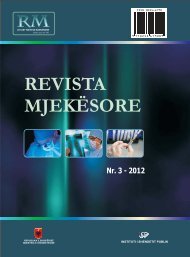in Albania - Instituti i Shendetit Publik
in Albania - Instituti i Shendetit Publik
in Albania - Instituti i Shendetit Publik
You also want an ePaper? Increase the reach of your titles
YUMPU automatically turns print PDFs into web optimized ePapers that Google loves.
INTERNATIONAL PUBLIC HEALTH CONFERENCE IN TIRANA, ALBANIAHealth risks from water and new challenges for thefutureArben Luzati 1 , Valbona Bara 1 , Oltiana Petri 1 , Anilda Kokali 1 , Anjeza Çoku 1 ,Mimoza Luzati 11Institute of Public Health, Tirana, <strong>Albania</strong>.Water is a very important element for the humanexistence, as a necessity for the economy, <strong>in</strong>dustryand agriculture. Water sources occupy 71% of theland surface and only 1% of this amount, locatedunderground, consists of dr<strong>in</strong>k<strong>in</strong>g water, while therest is salt water. The ma<strong>in</strong> water reserves arerepresented by: i) surface waters <strong>in</strong>clud<strong>in</strong>g waters ofthe oceans, seas, rivers, lakes and pools; ii)groundwater <strong>in</strong>clud<strong>in</strong>g natural groundwaterresources, hydro-geological, <strong>in</strong>dividual or collectivewater wells, and; iii) free water, which is constantlypresent <strong>in</strong> the air (water vapour).<strong>Albania</strong> is one of the first countries <strong>in</strong> Europe forpossession of abundant water resources, which varyfrom 5-1500 L/ sec. Although the quantities aresufficient to meet current needs, water quality is oftenproblematic due to pollution, especially <strong>in</strong> lowlandareas, where most of the <strong>Albania</strong>n population residescurrently. Also, <strong>in</strong> these areas take place most of theurban and agricultural <strong>in</strong>dustrial activities. Waterpollution implies the presence of microorganisms andchemical substances, toxic and radioactive substancesthat are classified as harmful for humans.Water pollution may be bacteriological, physicalchemical,toxic and radioactive. Bacteriologicalpollution of water is caused by bacteria, viruses,parasites eggs, which cause serious diseases such astyphoid, cholera, hepatitis A, salmonella, etc.Chemical pollution is caused by waste waterchlorides, nitrates, nitrites, ammonia, sulphates andphosphates. Toxic pollution is due to the presenceof heavy metals such as nickel, lead, cadmium,mercury, arsenic, z<strong>in</strong>c, and the presence of polycyclicaromatic hydrocarbons, artificial chemical fertilizers,pesticides, or oil products with high sulphurconcentration. The ma<strong>in</strong> means of radioactivepollution consist of nuclear explosions result<strong>in</strong>g <strong>in</strong>radioactive precipitations, which may contam<strong>in</strong>atenatural water sources. The radiation causes anioniz<strong>in</strong>g action to liv<strong>in</strong>g cells, lead<strong>in</strong>g to differentchanges <strong>in</strong> the molecular structure that are associatedwith subsequently somatic and genetic consequences.The monitor<strong>in</strong>g of dr<strong>in</strong>k<strong>in</strong>g water still rema<strong>in</strong>s anirreplaceable activity <strong>in</strong> provid<strong>in</strong>g <strong>in</strong>formation onwater quality. Monitor<strong>in</strong>g activities can also beenriched with <strong>in</strong>novative tools, such as genotyp<strong>in</strong>gand bio-molecular methods, particularly usefuldur<strong>in</strong>g <strong>in</strong>cident and outbreak <strong>in</strong>vestigations <strong>in</strong>attribut<strong>in</strong>g sources and establish<strong>in</strong>g correct<strong>in</strong>terventions.In most of the developed countries, but also <strong>in</strong>transitional countries such as <strong>Albania</strong>, there are nosurveillance systems on water-borne diseasesprobably reflect<strong>in</strong>g the belief that these diseasesbelong to the past.A fairly recent argument of public concern is dueto the awareness of the possible simultaneousoccurrence <strong>in</strong> water of a wide variety of substancessuch as pharmaceuticals, pesticides <strong>in</strong> non-agriculturalareas, chemical substances that <strong>in</strong>teract with theendocr<strong>in</strong>e system, personal care products, surfactants,etc. New challenges are also posed from theexpansion of potentially harmful microalgae andciuanobacteria <strong>in</strong> new ecosystems as a consequenceof <strong>in</strong>tensification of <strong>in</strong>tercont<strong>in</strong>ental trafficand climate change.Keywords: dr<strong>in</strong>k<strong>in</strong>g water, pollution, risk assessment, water.ALBANIAN MEDICAL JOURNAL SUPPLEMENT67




